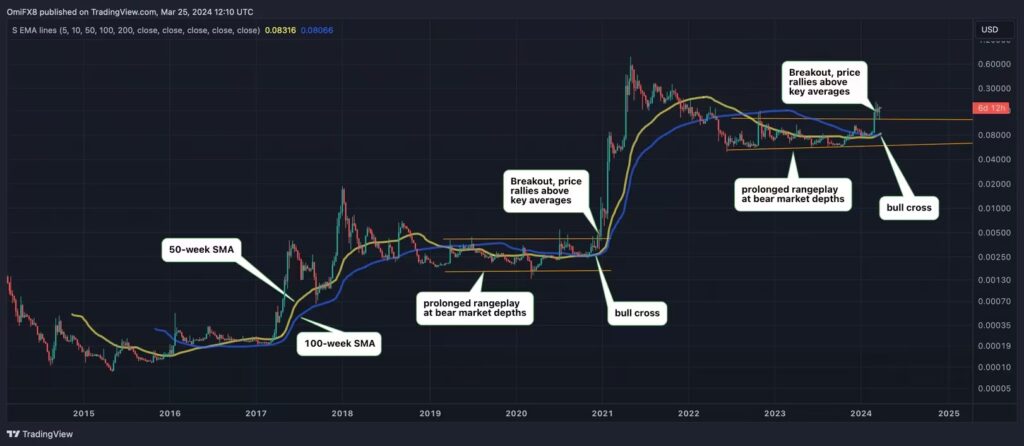Will Dogecoin See a Return to Its Late 2020 Glory?
- Today’s price movement of DOGE strikingly resembles the trend at the end of 2020.
- As Dogecoin soared over 1,000% at the start of 2021, the so-called fractal is noteworthy.
A key principle of Dow Theory is that asset price trends are self-repeating, following Mark Twain’s saying, “History never repeats itself, but it often rhymes.” Therefore, traders should frequently check if the current price movement resembles the past to understand future outcomes.
Dogecoin, the world’s largest meme cryptocurrency, has recently risen above the widely tracked 50, 100, and 200-week simple moving averages, ending a bear market consolidation that lasted 20 months. The 50-week moving average has crossed over the 100-week moving average, indicating a bullish momentum shift.
Both developments are strikingly similar to the scenario at the end of 2020. The so-called fractal is noteworthy, as DOGE witnessed an explosive rebound in the first five months of 2021.

Today’s price movement of DOGE strikingly resembles the trend before the last bull market started at the beginning of 2021. (TradingView)
Doge spent 20 months in the depths of a bear market, with prices ranging between 5 to 15 cents, then broke out of that range at the end of last month.
A similar 20-month bear market consolidation in late 2019 and 2020 laid the groundwork for the massive rise at the beginning of 2021. At that time, the cryptocurrency soared 3,600% to 37 cents by May 2021.
Thus, if the 2019-20 fractal is a guide, then the path of least resistance for DOGE might be on the higher side. A close look at the chart reveals that DOGE’s uptrends are intense but rarely last more than six months. Meanwhile, the subsequent crashes and bottoming/consolidation process took nearly three years.
Another similarity between now and 2020 is the widespread expectation that major central banks, including the Federal Reserve, will cut interest rates in the coming months. Expectations for a new round of liquidity easing are a good sign for assets far from the risk curve. In 2020, global central banks kept rates at near-zero levels.
Nonetheless, past data do not guarantee future outcomes, especially for non-serious cryptocurrencies like DOGE and other memecoins. A potential bearish turn in Bitcoin, the leader of the cryptocurrency market, could drag DOGE lower on its own.